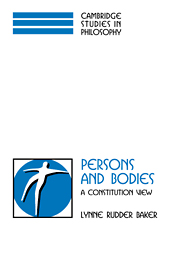3 - The First-Person Perspective
Published online by Cambridge University Press: 05 June 2012
Summary
According to the Constitution View, human persons are constituted by bodies. Constitution, as we have seen, is not identity. But if a person is constituted by a body to which she is not identical, what distinguishes a person from the body that constitutes her? My answer, which I shall explain in this chapter, is that a person has a capacity for a first-person perspective essentially; her constituting body has it contingently. The person/body case is thus analogous to the statue/piece-of-marble case. The statue has the property of being related to an artworld essentially; the constituting piece of marble has that property contingently. Having a capacity for a first–person perspective plays the same role in the human person case that being related to an artworld in such-and-such a way plays in the statue case.
A first–person perspective makes possible an inner life. On the Constitution View, something with a capacity for an inner life is a fundamentally different kind of thing from anything that has no capacity for an inner life. (Thus, I am ontologically closer to a self-conscious Martian than I am to a racehorse or to an early-term fetus.) The body of a human person is (identical to) an animal. An animal, human or not, can exist without any capacity for an inner life; a person cannot. This view is not Cartesian: An inner life does not require an immaterial soul, nor is it independent of the world around us.
- Type
- Chapter
- Information
- Persons and BodiesA Constitution View, pp. 59 - 88Publisher: Cambridge University PressPrint publication year: 2000



